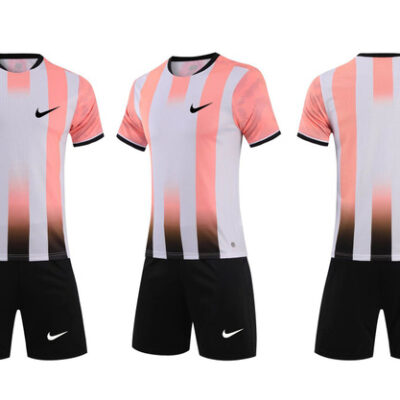If you’ve ever bought a plain sports jersey or wanted to customize one for yourself, you might have wondered, How to iron a number on a jersey? It’s a practical skill for athletes, fans, or even parents helping kids get ready for a game. While it might sound tricky at first, the process is simple once you understand the steps. With the right materials, a bit of patience, and some care, you can easily attach numbers to your jersey and make it look professional.
Why iron-on numbers are popular
Sports jerseys are meant to stand out, and numbers are an important part of that. They help identify players on the field, create a sense of team unity, and add a personal touch when you’re making a custom shirt. Buying a jersey with numbers already printed can be expensive, so many people choose to add iron-on numbers themselves. It’s cheaper, flexible, and gives you control over the design.
Another reason iron-on numbers are so common is that you don’t need special machines. You can do it at home with a household iron, some heat transfer numbers, and a steady surface. This makes it a practical option for small teams, school events, or even fans who want a personalized jersey for watching games.
The materials you’ll need
Before you get started, it’s important to gather everything. Having the right tools makes the process smoother and reduces the risk of mistakes.
The jersey fabric
Most jerseys are made of polyester, cotton, or a blend. Polyester is common for sports jerseys because it’s light and breathable, but it requires more care when ironing. Cotton is easier to work with, but it can shrink under too much heat. Always check the fabric label on your jersey before applying heat.
The numbers
You can buy pre-cut iron-on numbers online, at craft stores, or from sporting goods shops. They come in different sizes, colors, and fonts. Make sure the numbers match the look you want and fit the space on your jersey.
Iron and ironing board
A standard household iron works fine, but you’ll need one with adjustable heat settings. An ironing board or another flat, heat-resistant surface is necessary to keep the fabric stable while pressing.
Protective cloth
To avoid burning the fabric or sticking the numbers directly to the iron, you’ll need a thin piece of cotton cloth or parchment paper to place over the number during pressing.
Preparing the jersey
Preparation is one of the most important steps. If you skip it, you risk wrinkles, poor adhesion, or uneven placement.
Wash and dry the jersey
Wash the jersey before applying numbers. This removes any dirt, chemicals, or oils that could prevent the adhesive from sticking properly. Make sure it’s fully dry before ironing.
Flatten the surface
Lay the jersey on the ironing board and smooth out any wrinkles. Use the iron on a low setting to gently press the fabric flat if needed. A smooth surface helps the numbers bond evenly.
Decide placement
Think carefully about where you want the number. Most jerseys have numbers on the back, sometimes on the front, and occasionally on the sleeves. Use a ruler or tape measure to center the number. You can mark lightly with chalk or masking tape to guide your placement.
The ironing process
Once you’re prepared, it’s time to attach the number. This part requires patience and care.
Step one: Preheat the iron
Set your iron to the temperature recommended on the package of your iron-on numbers. For polyester jerseys, use a medium heat setting. For cotton, you can go slightly higher. Turn off steam, as moisture can interfere with the adhesive.
Step two: Position the number
Place the number in the exact spot you marked earlier. Double-check the alignment—it should be straight and centered. Once heat is applied, you won’t be able to move it without damaging the fabric.
Step three: Protect the fabric
Place a thin cotton cloth or parchment paper over the number. This prevents the adhesive from sticking directly to the iron and protects the jersey fabric from direct heat.
Step four: Apply pressure
Press the iron firmly over the covered number for 10–15 seconds. Do not move the iron back and forth, as this can cause the number to shift. Lift and press down again if the number is larger than the iron surface.
Step five: Let it cool
After pressing, allow the number to cool for a minute or two. Cooling helps the adhesive set properly. Once cooled, gently check the edges of the number. If any part is lifting, cover it again and press with the iron for a few more seconds.
Common mistakes and how to avoid them
Even though ironing numbers is simple, mistakes happen. Knowing them in advance helps you avoid problems.
Using too much heat
High heat can scorch polyester jerseys or cause the adhesive to bubble. Always follow the recommended temperature and test on a small area if you’re unsure.
Not applying enough pressure
If you only touch the iron lightly, the number may not bond well and could peel off after washing. Firm, even pressure is important.
Poor alignment
Crooked numbers look unprofessional and are hard to fix. Take your time measuring and marking before ironing.
Skipping the protective cloth
Direct heat can ruin the jersey or stick the number to your iron. Always use parchment paper or a cotton cloth as a barrier.
Caring for your jersey after ironing numbers
Once your numbers are attached, you’ll want to make sure they last. Proper care ensures they don’t peel or crack after a few washes.
Washing tips
Turn the jersey inside out before washing. Use cold water and a gentle cycle to prevent the numbers from loosening. Avoid harsh detergents or bleach, which can damage the adhesive.
Drying tips
Air drying is the safest method. If you use a dryer, keep it on low heat. High heat can weaken the glue and cause peeling.
Ironing after application
If the jersey wrinkles later, avoid ironing directly over the numbers. Instead, place a cloth over them or iron around the design. Direct heat can cause the adhesive to soften and lift.
Other ways to apply numbers
While ironing is common, there are alternative methods for applying numbers to jerseys.
Heat press
A heat press works like an iron but provides more consistent heat and pressure. Many teams and shops use heat presses for professional results. If you have access to one, it can make the job easier.
Sewing around the edges
For extra durability, some people stitch around the edges of iron-on numbers. This prevents peeling over time and adds a decorative outline.
Custom printing services
If ironing or sewing feels overwhelming, you can always take your jersey to a print shop. They can apply numbers using specialized equipment. It costs more, but the finish is usually flawless.
Why ironing numbers at home is worth trying
Doing it yourself saves money, teaches a useful skill, and gives you a sense of accomplishment. You can customize jerseys for a whole team or make one special shirt for yourself. With practice, you’ll be able to apply numbers neatly and confidently.
Adding personal touches
Once you’ve mastered numbers, you can also try iron-on letters for names or slogans. This makes your jersey even more unique. Fans often add their favorite player’s name, while kids love having their own names on the back.
Conclusion
Learning How to iron a number on a jersey? is a useful skill that combines creativity with practicality. With the right materials, preparation, and patience, you can attach numbers that look clean and professional. Avoiding common mistakes, caring for your jersey properly, and experimenting with different methods will make your projects even better. Whether it’s for a sports team, a personal keepsake, or just for fun, ironing on numbers is a rewarding and simple process.
FAQs
Can I iron numbers onto any type of jersey?
Most jerseys can handle iron-on numbers, but polyester requires lower heat than cotton. Always check the care label first.
How long will the numbers last?
If applied correctly and cared for properly, iron-on numbers can last through many washes without peeling.
What should I do if the number starts peeling?
You can reapply heat with a protective cloth to reattach it. If it continues peeling, stitching around the edges can help.
Can I remove an iron-on number later?
It’s difficult to remove completely without damaging the fabric. Once applied, it’s usually permanent.
Do I need a special type of iron?
No, a regular household iron works fine as long as it has adjustable heat settings and no steam.


